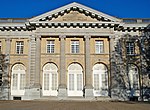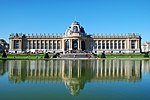Tervuren

Tervuren (; Dutch: [tɛrˈvyːrə(n)]) is a municipality in the province of Flemish Brabant, in Flanders, Belgium. The municipality comprises the villages of Duisburg, Tervuren, Vossem and Moorsel. On January 1, 2006, Tervuren had a total population of 20,636. The total area is 32.92 km², which gives it a population density of 627 inhabitants per km². The official language of Tervuren is Dutch. Local minorities consist primarily of French speakers and nationals of many countries of the European Union, the USA, and Canada. The reason for this diverse mix of nationalities is the presence of expatriate workers and their families working in and around Brussels, usually either for the European Union, NATO or for multinational corporations. The British School of Brussels has been located in Tervuren since 1970. Tervuren is also home of the English speaking St. Paul's Church, part of the Anglican ChurchTervuren is one of the richest municipalities in Belgium. It is linked to Brussels by a large processional avenue, Tervurenlaan, built by king Leopold II for the Universal Exhibition of 1897. This interweaves with a combined heritage and commuter tramline. Until 1959, Tervuren was also served by an electric railway, whose disused terminus opposite the Royal Museum for Central Africa became a pub named the Spoorloos Station (Trackless Station), currently named "Bar des Amis".
Excerpt from the Wikipedia article Tervuren (License: CC BY-SA 3.0, Authors, Images).Tervuren
Jezus-Eiklaan,
Geographical coordinates (GPS) Address Nearby Places Show on map
Geographical coordinates (GPS)
| Latitude | Longitude |
|---|---|
| N 50.816666666667 ° | E 4.5 ° |
Address
Jezus-Eiklaan 75
3080 (Tervuren)
Flemish Brabant, Belgium
Open on Google Maps








